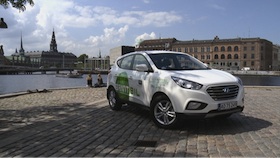Korean automaker expects to sell 1,000 fuel-cell crossovers by 2015.
 Copenhagen, Denmark, is trying to go “carbon-neutral” by 2025, and it's taken the first step with a delivery of 15 Hyundai ix35 Fuel Cells for its municipal fleet.
Copenhagen, Denmark, is trying to go “carbon-neutral” by 2025, and it's taken the first step with a delivery of 15 Hyundai ix35 Fuel Cells for its municipal fleet.
How does this help Copenhagen? Well, the car – a European version of the Tucson – is powered exclusively by hydrogen, and the only thing coming out of the tailpipe is water vapor – which Hyundai morbidly pointed out in acommercial mocking suicide. More appropriately, the delivery by Hyundai Motors Europe coincided with the opening of the first hydrogen filling station in Denmark. No mention of the price of hydrogen at said station, though.
During the handover, Byung Kwon Rhim, president of Hyundai Motor Europe, said that hydrogen would be "the fuel of the future for Europe." The company has made ix35s available to European Union policy-makers in Brussels through a program called the EU Fuel Cells and Hydrogen Joint Undertaking and wooed 100 European business reps at a special event in Berlin with test drives and product demonstrations. In May, Hyundai signed up with theU.S. Energy Department's H2USA program, which will combine government and industry forces to find ways to promote hydrogen-powered technology.
Let’s take a quick look at the stats on the Hyundai ix35 Fuel Cell:
You won't win any speed contests with this car, plain and simple. But it does offer performance comparable to most current compact hybrids and EVs, and it bests many all-electric cars in range. Plus, filling the tanks to maximum capacity takes just a few minutes, so no lengthy charging is required. Of course, you need a reliable spread of public hydrogen filling stations, and right now those are few and far between.
Hyundai is hoping the ix35 Fuel Cell will bring awareness for a pan-European hydrogen-refueling network. As of March, only 208 hydrogen refueling stations were operating worldwide, about 56 of them in the U.S. Even with those scant numbers, one enterprising group in a pair of ix35 Fuel Cells was able to drive 1,404 miles from Oslo, Norway, to Monaco using the existing hydrogen refueling network. Hyundai said it plans to build 1,000 cars by 2015.
Other automakers have made similar, albeit limited, progress on fuel-cell vehicles.
In January, Ford, Daimler and Renault-Nissan promised to sell a hydrogen-powered car by 2017 in a joint agreement. BMW and Toyota also are collaborating on fuel-cell technology and plan to release a jointly developed car by 2020, although Toyota will release its own car in 2015.
Honda has leased roughly 200 hydrogen-powered FCX Clarity models in Southern California, where the majority of the hydrogen refueling stations in the U.S. are located. The FCX Clarity is the first production hydrogen-powered car to be sold.
Mercedes-Benz, owned by Daimler, is leasing a few dozen hydrogen models in California that are based on the B-Class subcompact sold in Europe. Renault has tested a hydrogen-powered crossover, the Scenic ZEV H2, since 2008. Ford has also run a fleet of 30 hydrogen-powered Focus sedans since 2005.
Mercedes-Benz, owned by Daimler, is leasing a few dozen hydrogen models in California that are based on the B-Class subcompact sold in Europe. Renault has tested a hydrogen-powered crossover, the Scenic ZEV H2, since 2008. Ford has also run a fleet of 30 hydrogen-powered Focus sedans since 2005.
Later this year, Audi will open a renewable gas plant that will produce natural gas and hydrogen, making it the first automaker to build and run its own facility for such fuels.
But it's still a long shot. The so-called "Hydrogen Highway," part of which would connect Maine to Miami with hydrogen refueling stations, is still a concept, and with tax credits set to expire, the incentive to produce hydrogen – a complex and sometimes wasteful process – may float into the wind.
No comments:
Post a Comment